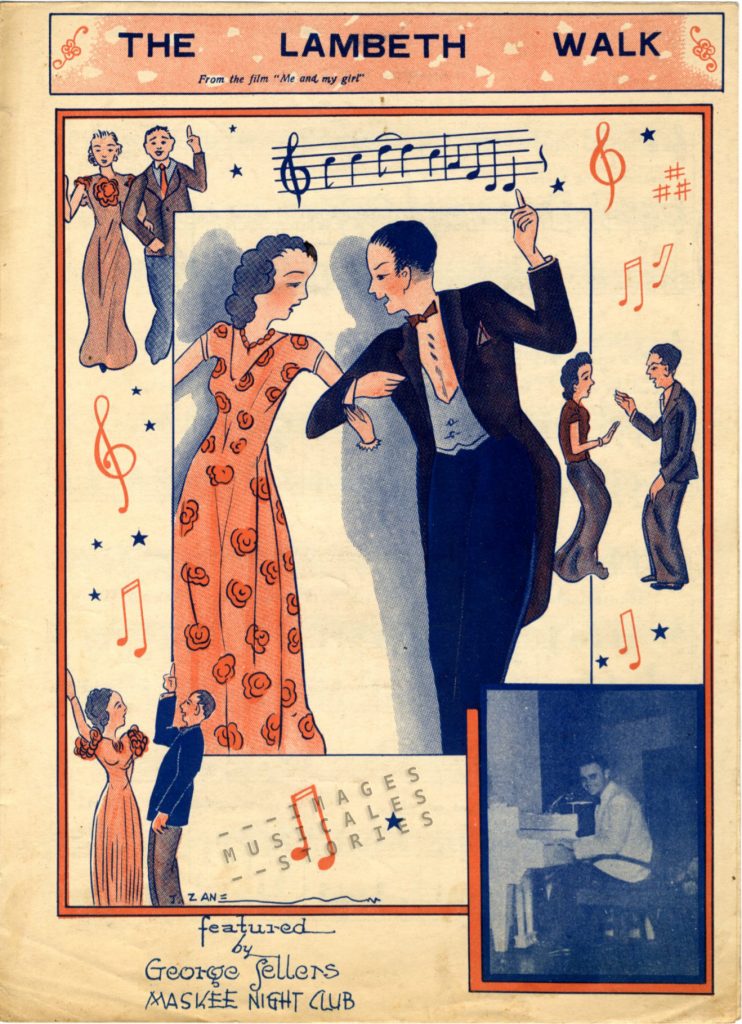
The naive drawing for The Lambeth Walk is a unicum in our collection. It’s the only one of our sheet music to have been published in Shanghai, which illustrates the song’s worldwide success. In 1937 the cheerful cockney Lambeth Walk started as an instant hit in England and soon rocketed to planetary triumph.

The Lambeth Walk was composed by Noel Gay for the musical Me and My Girl about a Cockney boy who in order to inherit a fortune must abandon his working-class ways. The musical was turned into a film in 1939. In the clip we see the leading character, played by Lupino Lane, telling all the snooty aristocrats: you should come to my working-class neighbourhood, and do this little dance we do. This dance starts with a strutting gait, thumbs cheerfully up in the air. Add to that some kicks, knee-slapping, risqué pelvis motion, turning around and shouting “Oi” all seemingly without end. Earworm alert: code red!
The strutting gait is the way London costermongers used to walk. Costermongers, or costers, were street sellers of fruit and vegetables for the labouring classes. They used melodic sales patter, poems and chants to attract attention. The distinctive culture of costers inspired many comedians and made them prime targets for songwriters.

The Lambeth Walk takes its name from a street in central London, once notable for its street market and working class culture. An article in the 1938 Picture Post wrote about Lambeth Walk: “In spite of its severe poverty it has a racy and vigorous life of its own.”

In 1942, Charles A. Ridley of the Ministry of Information manipulated parts from Leni Riefenstahl’s Triumph of the Will to ridicule Hitler and Nazi soldiers as if they were dancing the Lambeth Walk. The newsreel companies gave their own credits to the propaganda film. This copy is titled ‘Schichlegruber doing the Lambeth Walk’ referring to Adolf Hitler’s father who was born as Alois Schicklgruber.
Felix Nussbaum was a German Jewish painter who lived in hiding in Brussels during the war. His last known painting, Triumph of Death, shows skeletal figures making music in an apocalyptic world. It reads as an anticipation of the painter’s own doom. We see the despair on the face of the organ grinder, a self-portrait of Nussbaum. A few weeks after finishing this work in 1944, Nussbaum was arrested and shipped to Auschwitz where he died one week later. He had been betrayed by a neighbour.

In the left bottom of the painting, amid a pile of debris of the painter’s everyday life, lies a torn and crumpled piece of sheet music: it is the score from the Lambeth Walk. The detail tragically illustrates that for Nussbaum there was no more place for the simple tunes that can make people happy.
Doin’ the Lambeth walk
Ev’rything free and easy
Do as you darn well pleasey


What a nice & good & interesting story about the Lambeth walk and F. Nussbaum. Thanks for the info. Moniek B.
This is a marvelous post. To pull together the simple and cheerful Lambeth Walk with the tragic story of Felix Nussbaum is brilliant. Thank you.